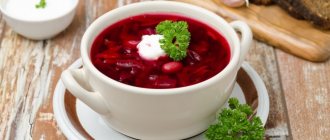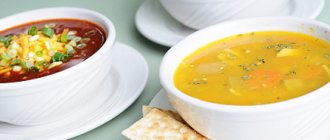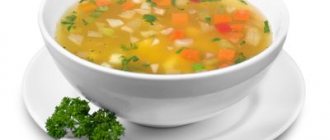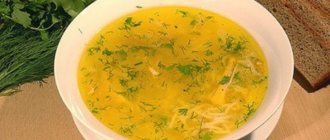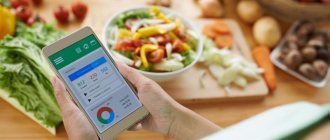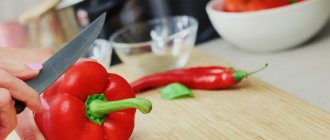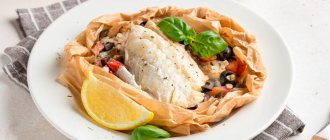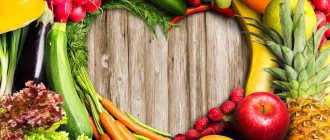Good day friends! Today I want to talk about a frequently asked question: how to calculate the calorie content and BJU ratio of a dish that consists of several ingredients and requires some kind of processing?
The answer to this question is capacious and has many nuances. I will not describe everything at once in this article, so as not to burden it. Let's consider the fastest, simplest method of calculation.
Why do you need to calculate the nutritional value of a finished dish?
Often, after cooking, dishes change their weight. For example, when cooked, pasta and cereals increase in volume and weight, while meat boils down and reduces these indicators.
Since calorie content is determined per 100 grams of product, it is inversely proportional to the weight of the finished dish. If the dish is reduced by 2 times, then its calorie content will increase by 2 times. This is a rough example though because usually the weight change is small. And the calorie content “jumps” by 50-60 kcal.
If you need to calculate the calorie content of any porridge.
Content
hide
How to count
Buckwheat porridge on water
Buckwheat porridge with milk or butter
Millet porridge on water
How to count
The calorie content of any porridge is calculated using one algorithm.
The calculation is based on weighing dry cereal.
Products are ALWAYS weighed dry and raw!
Because everyone can add their own amount of liquid and cook to different degrees of readiness. Some people like it messy, while others like it undercooked. Hence the different caloric content of ready-made dishes. The more water (liquid) you add, the lower the calorie content will be.
PS A small digression into the topic. The longer you cook the grain, the higher its GI (glycemic index) . And this is no good.
Or you can cook it yourself once and calculate exactly what your cooked cereal is and make a table of calorie content of boiled cereals.
*********************************
If you need to calculate the calorie content of the soup.
**********************************
Buckwheat porridge on water
That is, if you cook, for example, buckwheat porridge in water and take 100 grams of dry cereal, its calorie content will be 313 kcal, proteins 12.6 g, fats 3.3 g, carbohydrates 62.1 g.
Fill it with water and cook until the state of readiness suits you personally. Therefore, we do not count the amount of water; it will be different for everyone.
After the buckwheat has been cooked and turned into porridge, you need to weigh it.
It turned out that 100 grams of dry cereal yielded 423 grams of porridge . This means that boiled buckwheat increases 4.23 times. Therefore, wherever I eat it, the calorie content for me, according to the calculation, will be
74 kcal, proteins 3 g., fats 0.8 g., carbohydrates 14.7.
The calculations are as follows:
Calories 313: 4.23 = 73.99 rounded 74
Proteins 12.6: 4.23 = 2.97 round up 3
Fats 3.3: 4.23 = 0.78 rounded to 0.8
Carbohydrates 62.1: 4.23 = 14.68 rounded to 14.7
Buckwheat porridge with milk or butter
If you want to learn the calorie content of porridge with butter or milk, then there are two options - count it.
- You put the porridge on a plate, weigh it, for example, you get 100 grams and add milk or butter. For example, 100 grams of milk has 1.5 percent fat content. Then another 44 kcal will be added to your 74.
Calculation
Calories 74 + 44 = 118
Proteins 3 + 2.8 = 5.8
Fats 0.8 + 1.5 = 2.3
Carbohydrates 14.7 + 4.7 = 19.4
- You count calories for the entire volume.
For example, you cooked 100 grams of buckwheat, from which you got 423 grams of porridge, and added 500 grams of milk with 1.5 fat content.
Then the calculation will look like this:
Calories 423 + (44 * 5) = 643
Proteins 3 + (2.8 * 5) = 17
Fats 0.8 + (1.5 * 5) = 8.3
Carbohydrates 14.7 + (4.7 * 5) = 36.7
This will be the total calorie content of the dish, which weighs 923 grams.
Now we need to display the caloric value per 100 grams.
Calorie content (643 * 100) / 923 = 69.7 kcal
Proteins (17 * 100) / 923 = 1.8 kcal
Fat (8.3 * 100) / 923 = 0.9 kcal
Carbohydrates (36.7 * 100) / 923 = 4 kcal
Choose any option that you find convenient for yourself.
Millet porridge on water
Let's calculate millet porridge (millet groats) in the same way. Take 80 grams of dry, uncooked cereal and boil it in water.
From this amount I got 320 grams of boiled porridge.
This means that 100 grams of cereal will yield 400 grams of the finished product.
We make a note to ourselves that millet increases 4 times when cooked.
We consider KBJU the same as buckwheat porridge.
**********************************************************************
Dear readers! Thank you for your interest in my blog. I am sharing valuable knowledge with you free of charge and will be very grateful if you tell me about this article on your favorite social networks or recommend it to your family and friends.
Or just send the article or link to those who might find it helpful or interesting!
Maybe you need an individual consultation? more here.
Or here!
Did you like this article? Subscribe to site news (subscription form below) so as not to lose sight of the site. I am on many social networks (links in the right column, if you are reading from your phone - links at the bottom of the page)
Contact us on the website or Instagram @timoshenkoblog
*****************************
*****************************
When does the calorie content of a finished dish remain the same?
It is clear that this indicator remains the same in cases where the weight before and after cooking is the same. For example, when we prepare dishes without baking, boiling, frying, etc.
Ice cream, jelly, soufflé with gelling products, yogurt and fruit desserts, salads, sandwiches, and some sauces often do not change their calorie content.
Correction: when calculating the KBZHU of salads that use boiled vegetables, immediately take into account the caloric content of boiled vegetables, and not fresh ones.
Squirrels
1 gram of protein contains 4 kcal.
Proteins are the building blocks of the body; proteins are used to maintain muscles, for strong immunity, and to transmit signals between cells.
On average, it is recommended to consume proteins in the amount of 10-35% of daily calories. Big difference, isn't it? How much protein to consume depends on the nutritional goals a person wants to achieve, as well as age, health, body composition, and much more.
There is a lot of protein, for example, in poultry, meat, eggs, fish, tofu and lentils.
How to find out the KBJU of a specific ingredient?
The answer is simple - on the Internet. There are many sources where you can simply print out the data for the products you frequently use and do the calculations manually. There are services that automatically calculate the calorie content of the amount of ingredient you took.
I consider the Calorizer to be the most convenient for me - calorizator.ru. This service has several analyzers that will show you data not only for one product, but also calculate the sum of the indicators of all the ingredients that you took for the dish. (This is not an advertisement!).
Oatmeal: main characteristics
The product is created from whole oat grains, which are stripped of their shells and further processed: steamed and crushed into small pieces or flattened using a press. The latter option is used to prepare flakes: they are more popular than whole grains, but their benefits are controversial and the issue of their calorie content and effect on the figure should be approached separately.
Traditionally, oatmeal is cooked from cereals, which contain 342 kcal per 100 g serving. For flakes, this figure is higher and amounts to 366 kcal.
A 100g serving also contains 12g of protein, just 6g of fat and 59g of carbohydrates, most of which are fibre. It is noteworthy that the cereal has a higher level of carbohydrates (69 g), but slightly less protein. It is for its protein that oatmeal is highly valued in dietary nutrition, as it helps maintain not only high energy levels, but also maintain muscle mass when losing weight. In addition, in the chemical composition of oatmeal you can find:
- antioxidants;
- B vitamins;
- calcium, magnesium, zinc.
One of the main positive qualities of oatmeal is its effect on the digestion process: it improves intestinal function and rids the body of waste and toxins. At the same time, it does not cause a feeling of heaviness, as can happen with buckwheat. In addition, oatmeal is called a useful product for brain activity and bone tissue. The carbohydrates in it are predominantly slow, so the product is digested for a long time and does not turn into excess fat deposits. But all this is true for whole grains, but with dishes based on it the situation is more complicated.
How do I calculate KBJU? Step-by-step plan.
- First, we make a list of products that we use for the recipe. We determine on the website (I look in the Calorizer) the calorie content and nutritional value of each ingredient, and summarize these data. We get the total calorie content of all products before cooking. Let's call this number “Kcal 1”.
- You need to weigh each ingredient, so be sure to purchase a kitchen scale. Write down the numbers! This will make it easier to restore the recipe when calculating.
On a note! A scale is the most necessary unit in the kitchen after a saucepan. They are compact and cheap. Scales will greatly simplify your culinary life. And this applies not only to those who adhere to a healthy diet. Although for these comrades, scales are necessary, almost like water.
- After weighing, you can start cooking. After cooking, weigh the entire dish again. We do not take into account the capacity. I store food in containers. Therefore, I immediately select the appropriate one, weigh it empty, put food into it, and weigh it again. Then I subtract the weight of the empty container from the last number. Let's call this figure “Weight GB” (of the finished dish).
- We write down the resulting weight of the finished dish and go to calculate it.
Formula for determining the KBZHU of a finished dish (KBZHU GB)
- We substitute all the indicators in turn (calories, proteins, fats and carbohydrates) and get the calorie content and nutritional value of the finished dish.
How many calories are in buckwheat, oatmeal and other porridges?
The nutritional value of all cereals is approximately the same. Crumbly buckwheat porridge is considered the most energetic - 163 kcal. The calorie content of buckwheat porridge is not so high that you are afraid of getting fat from it. On the contrary, buckwheat porridge is used in a popular diet for weight loss; it consistently ranks first in the ranking. The energy value of oatmeal is low - only 80 kcal. The rest of the cereals are intermediate in calories.
Porridges up to 100 kcal in ascending order:
- rice;
- semolina;
- corn;
- millet;
- pea
Do not forget that the calorie content of raw cereals is much higher; it is important to pay attention to this when creating a diet menu. Read more about the nutritional value of cereals in our publication.
How to speed up calculations?
I never calculate using this formula, but simply enter all the data into the recipe analyzer on the Calorizer website. There is a separate window for changing the weight of the finished product. It is highlighted in white.
I list all the ingredients and their weight. The analyzer itself sums up weight and calorie content. First, Calorizer will calculate your indicators without taking into account weight changes. And then you just need to change the weight of the finished dish and the indicator will change itself.
It’s convenient that you don’t even have to measure some products on the scale. For example, I often write volume in tablespoons, teaspoons, cups, or pieces (for example, apple).
Tip: write down all the recipes you like in a food diary or cookbook indicating the KBZHU. Then you will have a good collection of recipes.
Reviews
Reviews from those who counted calories for weight loss:
Counting calories really helped me in terms of willpower and helped me get used to eating normally. Fried foods and flour (except for pizza and spaghetti) left my diet, but not because I forbade them. It’s just that when you are faced with a choice: a piece of cake that you will eat, and after 10 minutes you will want again, or a plate of rich soup, after which you will not feel hungry for the next 3 hours, the choice will become obvious
Those who have lost weight by counting calories are not afraid of the calculator



